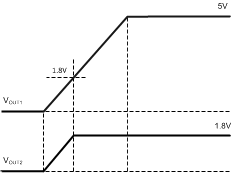SNVS276I April 2004 – February 2019 LM2743
PRODUCTION DATA.
- 1 Features
- 2 Applications
- 3 Description
- 4 Revision History
- 5 Pin Configuration and Functions
- 6 Specifications
- 7 Detailed Description
- 8 Application and Implementation
- 9 Power Supply Recommendations
- 10Layout
- 11Device and Documentation Support
- 12Mechanical, Packaging, and Orderable Information
Package Options
Mechanical Data (Package|Pins)
- PW|14
Thermal pad, mechanical data (Package|Pins)
- PW|14
Orderable Information
7.3.4 Tracking Voltage Slew Rate
The tracking feature can alternatively be used not to make both rails reach regulation at the same time but rather to have similar rise rates (in terms of output dV/dt). This method ensures that the output voltage of the LM2743 always reaches regulation before the output voltage of the master supply. Because the output of the master supply is divided down, in order to track properly the output voltage of the LM2743 must be lower than the voltage of the master supply. In this case, the tracking resistors can be determined based on the following equation:

For the example case of VOUT1 = 5 V and VOUT2 = 1.8 V, with RT1 set to 150 Ω as before, RT2 is calculated from the above equation to be 265 Ω. A timing diagram for the case of equal slew rates is shown in Figure 21.
 Figure 21. Tracking with Equal Slew Rates
Figure 21. Tracking with Equal Slew Rates